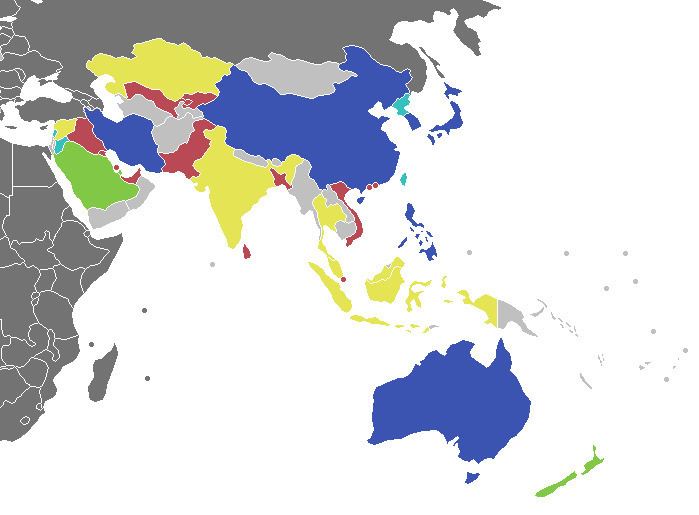Formerly FIBA Asia Championship Founded 1960 No. of teams 16 | Sport Basketball Inaugural season 1960 | |
 | ||
Country FIBA Asia member nations | ||
The FIBA Asia Cup (formerly FIBA Asia Championship) is an international basketball tournament which takes place every two years between men's national teams of Asia. This was the Asian qualifying tournament for the FIBA Basketball World Cup and the Olympic basketball tournament. The 2013 and 2015 was the last Asian Championship to serve as qualifiers to the FIBA Basketball World Cup and the Olympic Games.
Contents
- Beginnings
- Chinese dominance
- Renaming
- Removal of qualification status
- Qualification
- Tournament format
- Tournament leaders
- General statistics
- References
The 2015 FIBA Asia Championship was the last Asian Championship to be held as starting in 2017, it will be renamed as the FIBA Asia Cup and will now feature teams from FIBA Oceania.
Beginnings
The Asian Basketball Confederation (ABC) Championship was inaugurated in Manila in 1960. The championship was held to find Asia's best team and for qualification to the World Championship and the Olympics. On the next four tournaments, the Philippines won 3 with the Japanese beating the Filipinos on 1965. Korea, Japan and the Philippines split the next 3 championships until China debuted on 1975 at Bangkok with the championship, where they've dominated ever since.
Chinese dominance
From 1975 to 2007, there were only two instances where China didn't win the championship. In 1985, the Philippines defeated a full-strength Chinese team, which were by then five-time defending champions, in the championship round. The Chinese then won every game in the championship until 1997, where they to lost to South Korea in the semifinals where they complained about the climate in Riyadh. The Koreans beat the Japanese in the final, but the Chinese would then start a championship streak of four tournaments, led by Yao Ming.
Renaming
By 2005, the tournament had been renamed as the FIBA Asia Championship; in that year's tournament in Doha, the Chinese easily won against the Lebanese in the final. During the 2007 Championship, the Chinese did not send their "A" team since they had already qualified to the Olympics by virtue of hosting it. In this championship, West Asian teams started to compete with the traditional East Asian powers, as evidenced of an all-West Asian final when Iran defeated Lebanon. In 2009, Iran defeated the Chinese team A in the 2009 final to become only the 3rd team to successfully defend the championship. The 2009 championship started a streak of finals contested between a team from the Middle East and a team from the Far East; in 2011, Iran was eliminated by Jordan in the quarterfinals, which would then lose to hosts China by one point in the final. The 2013 Championship would be the first to be hosted outside East Asia since 2005 in the Philippines, the hosts, emerged as finalists; China had been eliminated by Chinese Taipei in the quarterfinals, which were then defeated by the Iranians, who then beat the Filipinos in the Final.
Removal of qualification status
As FIBA implemented a new cycle and tournament format, the 2013 FIBA Asia Championship held in Manila and the 2015 FIBA Asia Championship held in Changsha were the last Asian Championships to serve as qualification either to the FIBA Basketball World Cup and the Olympic Games. The 2017 FIBA Asia Championship will mark firsts and lasts for the Asian Championship, this will be the first Asian Championship as a standalone tournament (meaning will not serve as qualifier either for the Basketball World Cup or the Olympic Games). The 2017 Tournament will also expected to be the last Asian Championships to be ever held and under a 2-year cycle. Starting 2017, the Asian Championships and the FIBA Oceania Championship will merge into a one tournament to be known as the FIBA Asia Cup. It will be held every 4-years like the EuroBasket, AfroBasket and Americas Championship.
Qualification
Qualification is via the different FIBA Asia subzones. The East, Gulf, Southeast and West subzones receive two berths each, while the Central and South zones get one each. The host and the champion from the preceding FIBA Asia Cup also get a berth each. Each subzone conducts a qualification tournament up to a year before the championship to determine the qualifying teams. The other four berths are distributed to the subzones in reference to their performance in the previous year's FIBA Asia Cup, with the subzone receiving an extra berth for each team in the top four excluding the champion and the host.
Tournament format
There had been a variety of tournament formats used before. Most were similar to the current format of two group stages and a knockout stage. The current format, as first applied in 2009, is a multistage tournament. The 16 teams are grouped in four groups in the preliminary round. The teams play against each other once; the top three teams advance to the second round, where they're grouped into two groups of six teams, and they'll play three more teams from another preliminary round group once each. The top four teams in the second round advance to the final round, which is a single elimination tournament.
Teams eliminated in the preliminary round play in a single-elimination tournament for 13th place, while those out of the second round play for 9th place. There are also classification games for teams eliminated in the final round for 5th place.
Tournament leaders
General statistics
All-time statistics, as of the 2015 FIBA Asia Championship.
